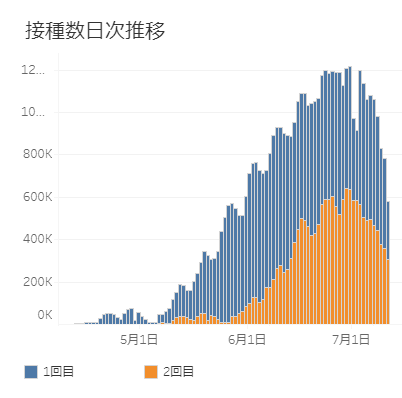My wife and I have received both of our shots, three weeks after the first shot. In not quite two weeks we will be fully vaccinated.
The first shot triggers an immune system reaction that produces antibodies against the spike protein of the virus. After about two weeks, the immune system also produces Memory T cells, which are its way of remembering how to make more antibodies should they be needed again in the future. After three or more weeks, when the second dose is given, it puts those newly formed T cells through their paces, boosting the antibody levels.
According to the latest published numbers for Tokyo, the more infectious Delta variant already causes more new cases than all other strains of SARS-CoV-2 combined and is most likely to completely displace them soon. This is part of the reason why the reproduction rate of the virus has been increasing for several weeks, with weekly averages of new cases growth accelerating from under 20 percent a week to over 50 percent recently.
Now it is crucially important that more people get shots as soon as possible. Not all prefectures and municipalities in Japan have made the same use of the vaccine they have received from the central government.
Tokyo has the questionable distinction as the prefecture with the largest portion of unused vaccine doses, even though people are desperate for vaccine appointments. By Sunday, July 25 Tokyo had received 15,227,660 doses. According to the Vaccination Recording System (VRS), 4,081,931 of these doses had been used as first doses and another 2,380,397 as second doses, for a total of 6,462,328 – just over 42 percent of the total. That means about 8.8 million doses either have not yet been reported after use or they’re still sitting in freezers, earmarked for shots that are weeks away.
The basic supply of future vaccines are going to be about 1.3 million doses every two weeks distributed to the municipalities in Tokyo by population by the central government and another 320,000 or so allocated to the prefecture to give to the cities that need extra supplies the most because they have the smallest stocks.
In the past week (July 19 through July 26), 8,620,790 doses have been distributed for general vaccinations in all of Japan. During the same period, 3,521,414 doses were used as first shots and 3,921,705 doses as second shots, for a total of 7,443,119 shots. The same picture shows in Tokyo, with delivered stocks growing by 2,100,180 million (13,127,480 on 7/19 to 15,227,660 on 7/26) while only 895,327 doses were used (502,489 first doses and 392,838 second doses).
This would actually mean that unused stocks in freezers grew, rather than being shrunk to vaccinate as many people as early as possible to protect them against the Delta variant. Vials in freezers do not protect against illness, only shots in arms do.
However, it is also possible that the recent 4-day long weekend (Thursday, 7/22 through Sunday, 7/25) caused bigger than usual delays in the VRS reports, in which case the actual results of vaccine use could be a little better than these numbers appear to show.

